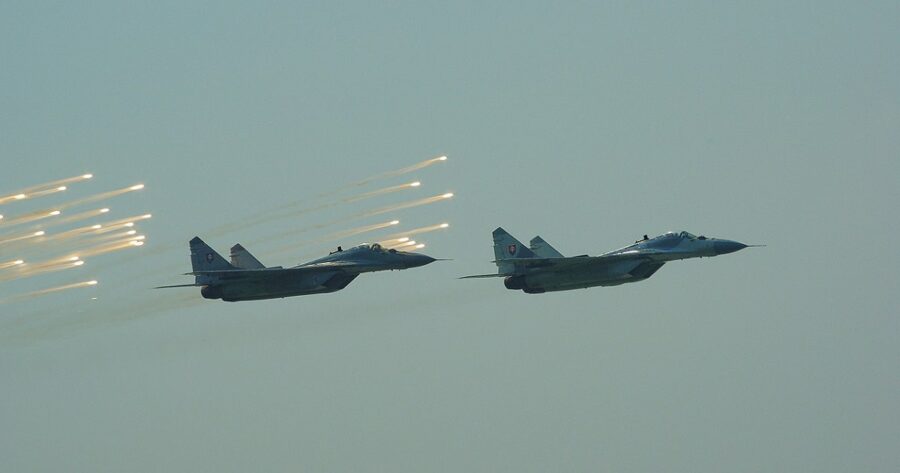In recent weeks, NATO countries have been supporting Ukraine in its ongoing conflict with Russia. Today, Slovakia has announced that it will send 13 MiG-29 fighter jets to Ukraine, while Poland has stated that it will deliver four MiG-29s in the coming days. This support comes in response to Ukraine’s repeated requests for assistance, particularly in the form of military hardware to help it counter Russian aggression.
The conflict in Ukraine began in 2014 when Russia annexed the Crimean peninsula and began supporting separatist rebels in the eastern regions of Donetsk and Luhansk. The conflict has since escalated into a full-scale war, with Russia invading Ukraine in February 2022, with both sides now engaging in regular exchange of fire.
The war has been devastating for Ukraine, with thousands of people killed and millions more displaced from their homes. It has also severely impacted the country’s economy and infrastructure, with large parts of the east of the country now in ruins. Despite numerous attempts to broker a peace deal, the conflict shows no sign of ending anytime soon.
One of the key issues in the conflict has been the lack of air support for Ukrainian forces. Russia has a large air force, including advanced fighter jets, and has been using these to support its ground troops in eastern Ukraine. Conversely, Ukraine has a much smaller air force, which has been struggling to compete with the Russian air force.
Ukraine has repeatedly asked NATO countries for assistance in this regard, including the provision of fighter jets. However, many countries have been reluctant to provide such support, citing concerns about escalating the conflict or angering Russia. In addition, many of the fighter jets used by NATO countries are American-made, and there are strict agreements in place regarding the transfer of such technology to other countries. Despite these concerns, Ukrainian officials have welcomed Slovakia and Poland sending MiG-29s, who see it as a much-needed boost to their air capabilities.
The decision to provide support in this way is not without risks. Russia has already warned that it sees the provision of fighter jets to Ukraine as hostile and has threatened to respond in kind. There are concerns that this move could escalate the conflict and lead to an even more dangerous situation.
However, there are also arguments in favour of providing this kind of support. Ukraine is a sovereign nation and has the right to defend itself against aggression. By providing fighter jets, NATO countries are helping Ukraine to do just that. This could help to deter Russia from further aggression and may even help to bring about a negotiated settlement to the conflict.
The conflict in Ukraine has been a difficult issue for NATO, which has struggled to find a united response to Russian aggression. While some NATO countries have been supportive of Ukraine, others have been more cautious and concerned about provoking Russia or escalating the conflict. This has led to a certain amount of division within the alliance.
However, the recent decision by Slovakia and Poland to send fighter jets to Ukraine suggests that there is still support for Ukraine within NATO. This could help strengthen the alliance and bring a more united response to Russian aggression. Despite the potential benefits of providing support to Ukraine, there are also risks associated with this move. The conflict in Ukraine is already a dangerous and volatile situation, and the provision of fighter jets could escalate the situation further. Russia has already warned that it sees the provision of fighter jets as a hostile act and has threatened to respond in kind. This raises the possibility of a wider conflict, which could have serious consequences for the region and beyond.
Ultimately, the best way to resolve the conflict in Ukraine is through a negotiated settlement. The war has already caused significant damage to Ukraine and has severely impacted the region as a whole. A peaceful resolution is needed to allow for the rebuilding of the country and the restoration of normalcy.
To achieve a negotiated settlement, both sides will need to make concessions. Russia will need to withdraw its support for the separatist rebels and recognize Ukraine’s sovereignty. On the other hand, Ukraine will need to make efforts to address the concerns of Russian-speaking minorities in the east of the country and make a decision if it will abandon its pursuit of NATO membership.
International mediation will be necessary to help bring the two sides together. The Minsk agreements, which were signed in 2015, are one example of such mediation. These agreements called for a ceasefire and for the withdrawal of heavy weapons from the conflict zone. While the agreements have not been fully implemented, they do provide a basis for further negotiations.









